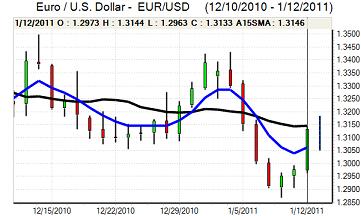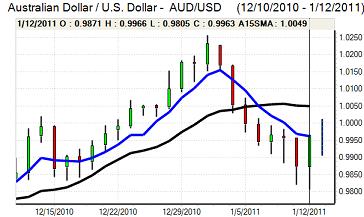EUR/USD
The Euro found support on dips to the 1.2960 area against the dollar on Wednesday and advanced to test resistance levels near 1.3060 later in the European session. This is an important area technically a representing the 200-day moving average and the Euro was able to gain further buying support as it broke above this level with a peak just above 1.3140.
The Euro-zone debt situation remained an important focus and there was some relief over the latest Portuguese debt-auction results, although the outcome was still mixed. Markets will also monitor the Spanish auctions on Thursday and firm investor support would boost confidence, especially if there is evidence of Far-East buying.
There was a renewed pledge of support for the Euro by German Chancellor Merkel who stated that everything would be done to protect the currency. There will also be further speculation over an expansion of the EU support fund and more favourable loan terms. There will, however, be strong internal opposition to further support and this is an extremely important factor within Germany given the number of state elections due in 2011.
There were no major US economic data releases during the day and the Beige Book was broadly in line with recent expectations. Economic conditions were reported to be stronger, but there were still important areas of concern. Regional Fed President Fisher stated that, barring surprises, the central bank was likely to complete the quantitative easing programme.
The dollar will tend to gain less defensive support when confidence in the global economy and risk appetite improves.

Source: VantagePoint Intermarket Analysis Software
Call now and you will be provided with FREE recent forecasts
that are up to 86% accurate * 800-732-5407
If you would rather have the recent forecasts sent to you, please go here
Yen
The dollar was unable to break above 83.50 against the yen on Wednesday and retreated to lows near 82.80, but the US currency was broadly resilient and the yen maintained a generally weaker tone on the crosses.
Domestically, the economic data was weaker than expected with a 3.0% November decline in machinery orders compared with expectations of a monthly increase. Overall confidence in the economy remains weak and this will continue to be a negative factor for the Japanese currency.
Overall risk appetite remains generally firm and commodity prices have remained strong which will tend to increase the risk of yen selling. There is also evidence that overseas investors have cut their holdings of Japanese bonds which would be a negative yen factor and the dollar was able to consolidate close to 83.
Sterling
Sterling found support on dips to below 1.56 against the dollar on Wednesday and in a repeat of the pattern seen over the past few days it moved higher during the day with a peak close to 1.5780. It was again resilient to generally unfavourable economic news with losses after a record goods trade deficit of GBP8.7bn recouped quickly. In this context, generally firm risk appetite is providing support for Sterling
There are inflation concerns within the economy and there has been further speculation that the Bank of England will move to a tightening of monetary policy at Thursday’s meeting.
Sterling will certainly spike higher if rates are increased, although it is more likely that policy will be left on hold at this meeting which could leave Sterling vulnerable to a correction.
There will also be underlying unease over economic conditions with a combination of weaker growth and higher inflation unlikely to provide durable currency support.
Swiss franc
The franc briefly strengthened to beyond 1.26 against the Euro during European trading on Wednesday, but was then subjected to renewed selling pressure with lows beyond 1.2720. The dollar generally drifted lower after failing to break above 0.9750 against the Swiss currency.
National Bank member Jordan stated that the franc’s strength was posing renewed threats to growth, although he also stated that there were no deflation of inflation threats at this time. There will be further pressure from the government and industry groups for franc strength to be curtailed, but Jordan gave no indication that the central bank was set to resume intervention.

Source: VantagePoint Intermarket Analysis Software
Call now and you will be provided with FREE recent forecasts
that are up to 86% accurate * 800-732-5407
If you would rather have the recent forecasts sent to you, please go here
Australian dollar
The Australian dollar was initially blocked at the 0.9920 area against the US dollar, but then advanced to fresh highs near 0.9960 late in the US session. There was support from a generally weaker US dollar while strong commodity prices also provided support.
Domestically, the unemployment rate fell to 5.0% for December from 5.2% previously, but the increase in employment was weaker than expected at 2,300 after a 54,600 gain the previous month. There will be further unease over the impact of flood damage, although the impact may start to fade and the currency was more resilient than in previous days.



